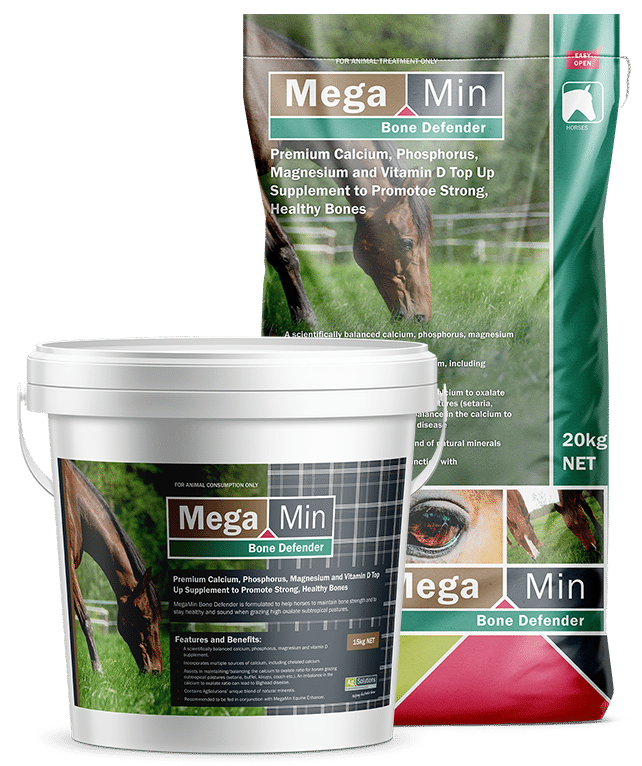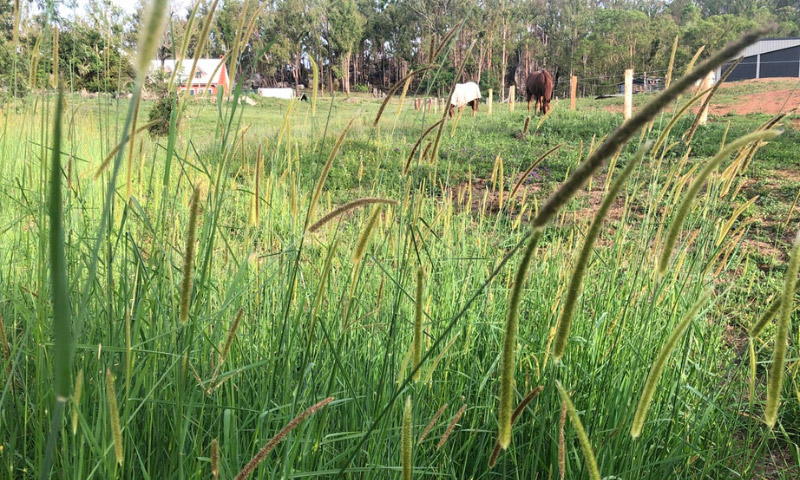Pastures that include setaria cultivars such as kazungula, narok, splenda, solander and nandi contain extremely high levels of a compound known as oxalate and are unsafe for horses to graze because without careful management and adequate calcium supplementation, horses are at risk of developing bighead disease.
When horses consume grasses that contain high levels of oxalate, the oxalate can attach to calcium in the small intestine (this could be calcium from the plant or from other dietary sources) and becomes calcium oxalate. The horse can’t use this calcium oxalate as calcium and eventually a significant calcium deficiency will occur resulting in the horse developing nutritional secondary hyperparathyroidism or bighead. When there isn’t sufficient calcium being absorbed from the horse’s diet, the horse will end up taking calcium from their bones to maintain their blood calcium levels. Often the first sign that bighead is an issue is when a horse breaks its leg due to their bones being brittle and weak from the excessive mobilisation of bone minerals.
To help avoid bighead it’s important to remember that when horses are grazing high oxalate pastures, they need to be given extra dietary calcium to keep the calcium to oxalate ratio above 0.5 parts calcium to 1 part oxalate as reported in the Control of nutritional secondary hyperparathyroidism in grazing horses with calcium plus phosphorus supplementation (McKenzie, 1981). When supplementing horses grazing high oxalate pastures like setaria they also require extra phosphorus because in the process of liberating calcium from the bones (an action controlled by the parathyroid gland), phosphorus is also released (calcium is combined with phosphorus in the bone) and excreted by the animal (McDonald, 2011).
The more oxalate the plant contains, the more dietary calcium will be bound by oxalate and the idea behind supplementation is to flood the system with extra calcium so there is enough calcium in the small intestine to be “free” and unbound by oxalate and therefore able to be absorbed by the horse.
It is well known that horses can succumb to bighead when they are grazing buffel and kikuyu pastures that contain oxalate levels around 15 g/kg of dry matter but setaria is so much worse with the level of risk depending on the type of setaria (Kazungula being the worst). The oxalate content in setaria varieties can range from 30 to 80 g/kg of dry matter and according to Dr Nerida Richards (2021) “it should really be classified as toxic for horses and a huge amount of extra calcium is needed to balance the ratio and prevent the development of bighead.”
Studies have shown that oxalate may have various roles in plants from calcium regulation, ion balance, tissue support, plant protection and heavy metal detoxification (Libert, 1987) and oxalate levels appear to increase when the plant is stressed such as in drought conditions (Tooulakou, 2016).
Nitrogen and potassium fertiliser application is also thought to increase oxalate levels in plants with a study conducted by Jones and Ford (1972) reporting that the oxalate content in setaria increased from 3.3% to 5.6% as urea level increased from 0 to 200 kg/ha. It is thought that when nitrogen is provided as nitrate in plants, several hydroxyl ions (OH) are produced and the increased levels of OH may act as a signal to stimulate organic acid biosynthesis, therefore the increase in oxalic acid (Rahman, 2011). A study conducted by Smith (1972) indicated that total oxalate content in setaria increased with an amplified rate of potassium application. Rahman (2011) also states that the overall application of potassium fertiliser with moderate to high levels of nitrogen enhances oxalate accumulation in plants and recommends that potassium fertilisation should be kept low to avoid excess levels of soluble oxalate.
Don’t believe the ‘old wives tale’ that if you mow or slash setaria, it makes it safer. Numerous researchers (Jones, 1972), (Marais, 1997), (Rahman et al, 2014), have reported that oxalate content is also at its highest in leaf tissue, followed by stem tissue, and Rahman (2006) additionally found that oxalate levels are highest in early Summer. This information is also acknowledged by the Tropical Forages website (Tropical Forages, 2021) that states, “oxalate levels in setaria are higher in fresh growth and is also exacerbated by nitrogen and potassium fertilisation”. So, when you constantly slash grass, you are keeping it at the fresh growth stage and therefore, at the level with the highest oxalates.
Therefore, if you have horses grazing setaria you need to be very mindful that you provide enough supplemental calcium (along with phosphorus) to balance the calcium to oxalate ratio, while maintaining the desired calcium to phosphorus ratio (1:1 to 6:1 for the mature horse and 1:1 to 3:1 for young horses). Oxalate is also believed to bind with dietary magnesium and could potentially lead to low blood magnesium levels as well as calcium (Rahman MM., 2013) so providing additional magnesium in balance to calcium could also be of benefit in a supplement. Giving your horse time off high oxalate pasture and providing them with lucerne hay are additional strategies to help them absorb more calcium from the diet.
Never forget that when giving your horse a supplement, that about three times more calcium will be needed for horses grazing setaria species as compared to when they are on buffel or kikuyu pasture. In addition, all other mineral requirements will also need to be met to help maintain overall health and bone strength.
MegaMin Bone Defender is a top up supplement designed to provide extra calcium, phosphorus, magnesium, and vitamin D to assist in maintaining or balancing the calcium to oxalate ratio for horses grazing subtropical pastures. Bone Defender comes with a very detailed feeding guide that factor in the horse’s requirements for calcium in relation to its weight, workload, reproductive status, and age. This guide also considers the extra calcium required to balance the extremely high levels of oxalate found in setaria species.
To assist horse owners in ensuring that their animals are receiving a well-balanced diet AgSolutions offer MegaMin Equine Supplement customers a free feed review, analysis, and discussion to help fine-tune their horse’s requirements. The Equine Diet Analysis request form can be downloaded from https://agsolutions.com.au/horsedietanalysis/.
For more information on the MegaMin Equine Supplement range visit our website www.agsolutions.com.au or contact our Head Office on 1800 81 57 57.

